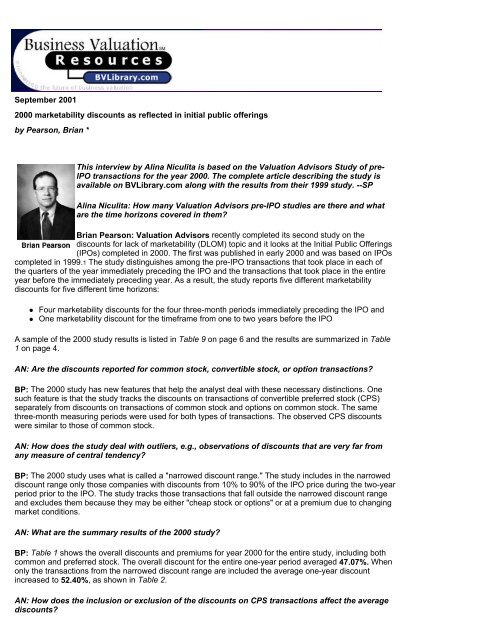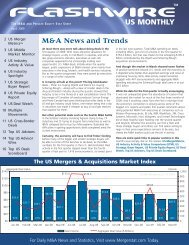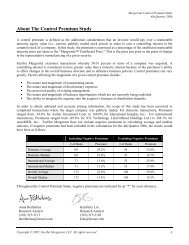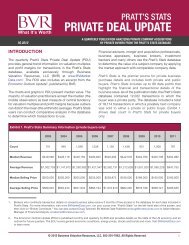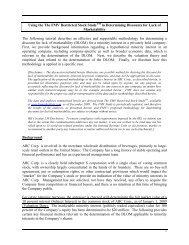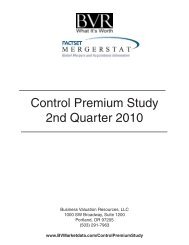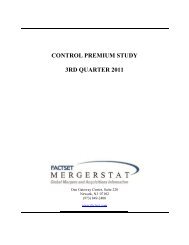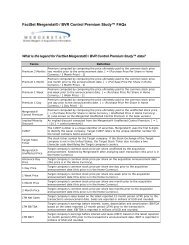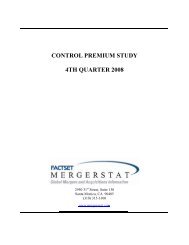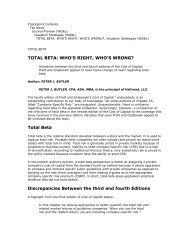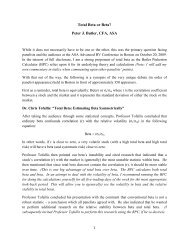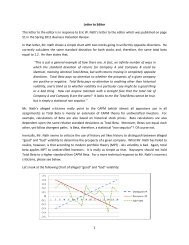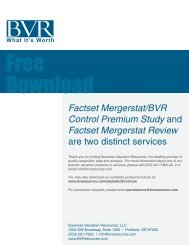2000 Marketability Discounts as Reflected in Initial ... - BVMarketData
2000 Marketability Discounts as Reflected in Initial ... - BVMarketData
2000 Marketability Discounts as Reflected in Initial ... - BVMarketData
You also want an ePaper? Increase the reach of your titles
YUMPU automatically turns print PDFs into web optimized ePapers that Google loves.
September 2001<strong>2000</strong> marketability discounts <strong>as</strong> reflected <strong>in</strong> <strong>in</strong>itial public offer<strong>in</strong>gsby Pearson, Brian *This <strong>in</strong>terview by Al<strong>in</strong>a Niculita is b<strong>as</strong>ed on the Valuation Advisors Study of pre-IPO transactions for the year <strong>2000</strong>. The complete article describ<strong>in</strong>g the study isavailable on BVLibrary.com along with the results from their 1999 study. --SPAl<strong>in</strong>a Niculita: How many Valuation Advisors pre-IPO studies are there and whatare the time horizons covered <strong>in</strong> them?Brian Pearson: Valuation Advisors recently completed its second study on thediscounts for lack of marketability (DLOM) topic and it looks at the <strong>Initial</strong> Public Offer<strong>in</strong>gs(IPOs) completed <strong>in</strong> <strong>2000</strong>. The first w<strong>as</strong> published <strong>in</strong> early <strong>2000</strong> and w<strong>as</strong> b<strong>as</strong>ed on IPOscompleted <strong>in</strong> 1999.1 The study dist<strong>in</strong>guishes among the pre-IPO transactions that took place <strong>in</strong> each ofthe quarters of the year immediately preced<strong>in</strong>g the IPO and the transactions that took place <strong>in</strong> the entireyear before the immediately preced<strong>in</strong>g year. As a result, the study reports five different marketabilitydiscounts for five different time horizons:• Four marketability discounts for the four three-month periods immediately preced<strong>in</strong>g the IPO and• One marketability discount for the timeframe from one to two years before the IPOA sample of the <strong>2000</strong> study results is listed <strong>in</strong> Table 9 on page 6 and the results are summarized <strong>in</strong> Table1 on page 4.AN: Are the discounts reported for common stock, convertible stock, or option transactions?BP: The <strong>2000</strong> study h<strong>as</strong> new features that help the analyst deal with these necessary dist<strong>in</strong>ctions. Onesuch feature is that the study tracks the discounts on transactions of convertible preferred stock (CPS)separately from discounts on transactions of common stock and options on common stock. The samethree-month me<strong>as</strong>ur<strong>in</strong>g periods were used for both types of transactions. The observed CPS discountswere similar to those of common stock.AN: How does the study deal with outliers, e.g., observations of discounts that are very far fromany me<strong>as</strong>ure of central tendency?BP: The <strong>2000</strong> study uses what is called a "narrowed discount range." The study <strong>in</strong>cludes <strong>in</strong> the narroweddiscount range only those companies with discounts from 10% to 90% of the IPO price dur<strong>in</strong>g the two-yearperiod prior to the IPO. The study tracks those transactions that fall outside the narrowed discount rangeand excludes them because they may be either "cheap stock or options" or at a premium due to chang<strong>in</strong>gmarket conditions.AN: What are the summary results of the <strong>2000</strong> study?BP: Table 1 shows the overall discounts and premiums for year <strong>2000</strong> for the entire study, <strong>in</strong>clud<strong>in</strong>g bothcommon and preferred stock. The overall discount for the entire one-year period averaged 47.07%. Whenonly the transactions from the narrowed discount range are <strong>in</strong>cluded the average one-year discount<strong>in</strong>cre<strong>as</strong>ed to 52.40%, <strong>as</strong> shown <strong>in</strong> Table 2.AN: How does the <strong>in</strong>clusion or exclusion of the discounts on CPS transactions affect the averagediscounts?
BP: When the CPS transactions are excluded, the narrowed discount range for common stock or optionsonly falls to 49.76%, <strong>as</strong> shown <strong>in</strong> Table 2.1, down from the 1999 figure of 52.44%. This likely <strong>in</strong>dicates thatmore premiums were paid than large discounts on pre-IPO transactions <strong>in</strong> <strong>2000</strong>.Table3 shows the discounts for the CPS-only pre-IPO transactions. With the exception of the first threemonths, all the other CPS periods, compared to the common-stock-only transactions, show re<strong>as</strong>onablylarger discounts. This may be expla<strong>in</strong>ed partially by the fact that these transactions typically are at largerdollar amounts than are the majority of the common stock and option transactions, thereby allow<strong>in</strong>g theventure capital firms engag<strong>in</strong>g <strong>in</strong> such transactions to negotiate better deal terms. Also, to the extent thatcommon-stock-b<strong>as</strong>ed transactions use CPS transactions <strong>as</strong> a benchmark, the common stock transactionsusually are priced higher thereafter, even though they may fall <strong>in</strong> the same three-month period.Table 1: Complete StudyResultsTime of Transaction Before IPO1-90 Days 91 - 180 Days 181 - 270 Days 271 - 365 DaysNumber of Transactions 123 165 105 86 134Average Discount 31.50% 43.58% 56.47% 64.39% 71.61%Average One-year discount 47.07%1-2Yrs.Table 2: Narrowed Discount RangeTime of Transaction Before IPO1-90 Days 91 - 180 Days 181 - 270 Days 271 - 365 DaysNumber of Transactions 99 146 94 73 106Average Discount 40.60% 49.29% 59.16% 65.95% 66.85%Average One-year discount 52.40%1-2Yrs.Table 2.1: Narrowed Discount Range - Exclud<strong>in</strong>g CPStransactionsTime of Transaction Before IPO1-90 Days 91 - 180 Days 181 - 270 Days 271 - 365 DaysNumber of Transactions 82 95 53 49 50Average Discount 39.56% 47.64% 56.98% 63.17% 63.54%Average One-year discount 49.76%1-2Yrs.Table 3: CPSTransactions OnlyTime of Transaction Before IPO1-90 Days 91 - 180 Days 181 - 270 Days 271 - 365 DaysNumber of Transactions 24 56 43 30 73Average Discount 31.83% 47.78% 57.51% 73.00% 75.45%Average One-year discount 52.96%1-2Yrs.AN: Sometimes, when try<strong>in</strong>g to me<strong>as</strong>ure discounts from IPO prices, premiums result <strong>in</strong>stead. Whydo pre-IPO premiums occur and w<strong>as</strong> <strong>2000</strong> a year of mostly pre-IPO premiums or discounts?
BP: Table 4 shows the number of premium transactions by quarter. A review of these transactions showsthat the majority of these transactions occurred dur<strong>in</strong>g the third quarter of <strong>2000</strong>. For those companies thatwere not "hot" offer<strong>in</strong>gs, the only way to complete an IPO <strong>as</strong> the year progressed w<strong>as</strong> to lower the IPOprice,2 sometimes more than once.3 As the IPO price w<strong>as</strong> lowered to generate additional <strong>in</strong>terestnecessary to complete the offer<strong>in</strong>g, the lowered price often ended up be<strong>in</strong>g lower than prior prices foroptions and common and preferred stock already issued or sold.Generally, <strong>as</strong> the stock markets fell <strong>as</strong> the year progressed, <strong>in</strong>vestors became more selective <strong>in</strong> <strong>in</strong>vest<strong>in</strong>g<strong>in</strong> IPOs.4 Thus, many companies lowered their offer<strong>in</strong>g prices to complete an offer<strong>in</strong>g <strong>in</strong> the third quarterwhile the IPO w<strong>as</strong> still possible. By November, half the <strong>2000</strong> IPOs were trad<strong>in</strong>g below their IPO price.5Essentially, <strong>as</strong> <strong>in</strong>vestors became more selective, they were less will<strong>in</strong>g to pay higher valuation multiplesfor all companies.AN: Are the discounts result<strong>in</strong>g from pre-IPO studies a good <strong>in</strong>dication of DLOM for <strong>in</strong>terests <strong>in</strong>private companies that will never have the possibility or the opportunity to go public?BP: Some valuation professionals have argued that the IPO studies calculat<strong>in</strong>g marketability discountsoverstate discounts, s<strong>in</strong>ce IPOs overstate the true "fair market value" price of a company’s shares.Generally, this is simply not true:• First, <strong>in</strong> both <strong>2000</strong> and early 2001, a number of companies had to lower their offer<strong>in</strong>g prices to gopublic. Over time, this tends to offset raised offer<strong>in</strong>g prices <strong>in</strong> better markets.• Second, <strong>in</strong> <strong>2000</strong>, a number of companies canceled their offer<strong>in</strong>gs because the IPO market simplydried up. Table 5, which is reproduced from IPOMonitor.com, shows a chart of companies thatwithdrew their offer<strong>in</strong>gs <strong>in</strong> each quarter of <strong>2000</strong>. There were 422 IPOs <strong>in</strong> <strong>2000</strong> and 232 of them—or53%—were withdrawn. None of the prior lack of marketability studies (<strong>in</strong>clud<strong>in</strong>g this) captures thepresumed <strong>in</strong>cre<strong>as</strong>e <strong>in</strong> lack of marketability <strong>in</strong> those companies whose offer<strong>in</strong>gs were canceled orwithdrawn.• Third, once an IPO is canceled, the company may be viewed differently by other potential <strong>in</strong>vestors,who recognize that one avenue for liquidity is closed, maybe permanently. Accord<strong>in</strong>g to a study byf<strong>in</strong>ance professor Craig Dunbar, only 10% of failed IPOs ever manage to go public at a later date.6• Fourth, to the extent a failed IPO means the company does not have fund<strong>in</strong>g to complete itsbus<strong>in</strong>ess strategies, its "attractiveness" to <strong>in</strong>vestors <strong>as</strong> a competitor <strong>in</strong> its <strong>in</strong>dustry is lessened."Withdraw<strong>in</strong>g an IPO is usually a crippl<strong>in</strong>g event, even if the company doesn’t realize it at thetime."7 Ironically, these drawbacks must be weighed aga<strong>in</strong>st the likelihood that the company maynow seek a buyer for itself <strong>as</strong> a strategy to cont<strong>in</strong>ue growth, thereby creat<strong>in</strong>g liquidity for <strong>in</strong>vestors.B<strong>as</strong>ed on the large number of companies that file and don’t go public, and those that simply will never beable to go public, one can argue that the discount for a private company could be higher than theaverages <strong>in</strong> this study.Table 4: Premiums ByQuarterQuarter Premiums Transactions % of Total1st 2 217 0.92%2nd 4 64 6.25%3rd 21 216 9.72%4th 5 116 4.31%TOTAL 32 613 5.22%Table 5: IPO's and Withdrawls <strong>in</strong><strong>2000</strong>Quarter IPO's Withdrawls1 Q <strong>2000</strong> 136 202 Q <strong>2000</strong> 95 78
3 Q <strong>2000</strong> 137 474 Q <strong>2000</strong> 54 87TOTAL 422 232Note: Reproduced from IPOMonitor.comAN: How could one go about estimat<strong>in</strong>g a DLOM for a private company start<strong>in</strong>g from the discountsreported <strong>in</strong> this study?BP: Accord<strong>in</strong>g to alert-IPO.com,8 "companies that priced IPOs <strong>in</strong> March this year had spent an average ofabout 73 days <strong>in</strong> registration, but <strong>in</strong> October the average number of days surged to 161."Table 6: Study Results - NAICS Code 325 and334NAICS325Time of Transaction Before IPO1-90 Days 91 - 180 Days 181 - 270 Days 271 - 365 Days 1-2 Yrs.Number of Transactions 8 13 7 6 15Average Discount 32.17% 49.66% 56.66% 64.81% 70.88%Average One-year discount 49.66%NAICS334Time of Transaction Before IPO1-90 Days 91 - 180 Days 181 - 270 Days 271 - 365 Days 1-2 Yrs.Number of Transactions 18 23 16 10 24Average Discount 30.46% 46.94% 58.79% 60.10% 69.07%Average One-year discount 47.31%If we <strong>as</strong>sume that the average IPO process (from fil<strong>in</strong>g to successful offer<strong>in</strong>g) takes approximately sixmonths, a way to calculate this additional lack of marketability is to look at the difference between sixmonth<strong>in</strong>tervals of our study. The discount difference between the 181-270 day period and the 1-2 yearperiod w<strong>as</strong> approximately 11.26% <strong>in</strong> <strong>2000</strong> and 11.35% <strong>in</strong> 1999. S<strong>in</strong>ce <strong>in</strong> both years, the discount for the181-270 day period is considerably greater than the average discount for all time periods, this may be agood b<strong>as</strong>e period to use <strong>in</strong> look<strong>in</strong>g at the discount for an additional theoretical six-month period.Clearly, the companies <strong>in</strong> our study are more liquid to an <strong>in</strong>vestor than the average privately held companyvalued. Thus, for an "average" privately held bus<strong>in</strong>ess, this may be one approach to captur<strong>in</strong>g thepotential additional lack of marketability that we need to consider further.AN: How are the pre-IPO transactions cl<strong>as</strong>sified <strong>in</strong> the Valuation Advisors study?BP: Similarly to l<strong>as</strong>t year, all the transactions <strong>in</strong> this study are cl<strong>as</strong>sified by NAICS code. Table 6 presentsthe companies <strong>in</strong>cluded <strong>in</strong> the NAICS codes 325 "Chemical Manufactur<strong>in</strong>g" and 334 "Computer andElectronic Product Manufactur<strong>in</strong>g." The discounts vary by NAICS code, number of transactions, and tim<strong>in</strong>gof the transaction (i.e., first vs. fourth quarters).Table 7 presents NAICS code 3391 or "Medical Equipment and Supplies Manufactur<strong>in</strong>g." The 21companies presented here went public from 1996 to 2001. There were 57 transactions, out of which 42took place less than one year before the IPO. The result<strong>in</strong>g discounts comport to the prior entire studyresults.AN: Does the study give any <strong>in</strong>sights <strong>in</strong>to the market activity level <strong>in</strong> the year <strong>2000</strong>?BP: An <strong>in</strong>terest<strong>in</strong>g fact that can be gleaned from the study is the nature of the "hot" market for IPOs <strong>in</strong> the
first quarter. This can be seen at Table 8, which separates the transactions by calendar quarter. In thethree months just prior to the IPO, the first quarter discount w<strong>as</strong> 41%, where<strong>as</strong> the next two quarters were<strong>in</strong> the low 20% range, and the f<strong>in</strong>al quarter w<strong>as</strong> 16.36%. This shows how IPO prices typically were raisedby underwriters <strong>in</strong> the first quarter, mostly ma<strong>in</strong>ta<strong>in</strong>ed <strong>in</strong> the second and third quarters, and often lowered<strong>in</strong> the fourth quarter.On balance, this also po<strong>in</strong>ts out the need to consider external market conditions. Clearly, the marketconditions at a valuation date do impact IPO valuations, and thus should be considered for privatecompanies, even <strong>in</strong> the context of discounts.Table 7: Study Results - NAICSCode 3391NAICS 3391Time of Transaction Before IPO1-90 Days 91 - 180 Days 181 - 270 Days 271 - 365 DaysNumber of Transactions 9 18 11 4 15Average Discount 43.93% 49.59% 56.88% 72.64% 80.26%Average One-year discount 52.48%Table 8: Study Results - 1-90 dayTransactions by QuarterQuarter1 Q<strong>2000</strong>2 Q<strong>2000</strong>3 Q<strong>2000</strong>4 Q<strong>2000</strong>Number OfTransactionsAverage Discount57 41.00%14 20.43%28 21.97%16 16.63%1-2Yrs.Click here (BVU0901-Figure9.xls/30kb) to download Table 9: Sample from <strong>2000</strong> IPO ValuationDiscount Study, Valuation Advisors, LLCClos<strong>in</strong>g remarksIt’s important to once aga<strong>in</strong> stress that each valuation c<strong>as</strong>e should be viewed differently, and that there isno "one discount fits all" answer. The Valuation Advisors <strong>2000</strong> and prior years’ studies clearly <strong>in</strong>dicate thatover many <strong>in</strong>dustries and multiple time periods, <strong>in</strong>vestors have paid less for an <strong>in</strong>vestment the furtheraway the transaction is from the IPO liquidity event. S<strong>in</strong>ce this is what a rational <strong>in</strong>vestor also would do,the Valuation Advisors Study results are a useful guide <strong>in</strong> gaug<strong>in</strong>g the lack of liquidity for closely heldstock.AN Comment: Readers can get a copy of the orig<strong>in</strong>al published study from AICPA by call<strong>in</strong>g (800) 862-4272.1Brian K. Pearson, "1999 <strong>Marketability</strong> <strong>Discounts</strong> <strong>as</strong> <strong>Reflected</strong> <strong>in</strong> <strong>Initial</strong> Public Offer<strong>in</strong>gs," CPA Expert(Spr<strong>in</strong>g <strong>2000</strong>): 1-6.2 Raymond Hennessey, "Firms Lower Prices, Withdraw Offer<strong>in</strong>gs As IPO Market Slows," Wall StreetJournal (Thursday, November 16, <strong>2000</strong>): C20.3 Raymond Hennessey, "New Year Won’t R<strong>in</strong>g <strong>in</strong> Bells <strong>in</strong> IPO Market," Wall Street Journal (Tuesday,January 2, 2001): C15.
4 Jed Graham, "IPO W<strong>in</strong>dow Shuts As Crop of Newly Public Firms Withers," Investors Bus<strong>in</strong>ess Daily(Friday, December 22, <strong>2000</strong>): A6.5 Matt Krantz, "With Fewer Filers, Lower Prices, IPO Market ‘Pretty Ugly Out There,’" USA Today(Monday, November 13, <strong>2000</strong>): 16B.6 Jon Birger, "Public Skeptical—A Company’s IPO Withdrawal Could Either Be Fatal, or a W<strong>in</strong>dfall," RedHerr<strong>in</strong>g (August <strong>2000</strong>): 354-356.7 Ibid.8 Denise Duclaux, "IPO View—New Stock Offer<strong>in</strong>gs Wait Out Rollerco<strong>as</strong>ter," Reuters Limited, via AmericaOnl<strong>in</strong>e.* Brian K. Pearson is president of Valuation Advisors, LLC, Amherst, New York, which specializes <strong>in</strong> bus<strong>in</strong>ess valuations and valuationconsult<strong>in</strong>g. He can be reached at (716) 839-5290 or bp@valuationspros.com .Copyright © 2002 Bus<strong>in</strong>ess Valuation Resources. All rights reserved.


